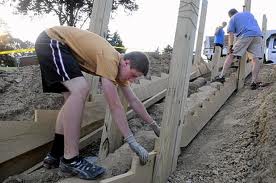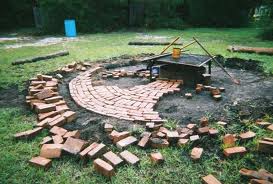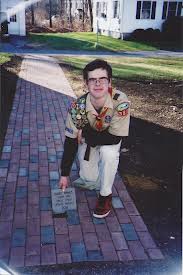SERVICE TO OTHERS
is a cornerstone of the Scouting Program. Giving back to your school, church or community.
SECOND CLASS SERVICE HOURS:
For the Second Class Rank, a Scout must participate in a service project or projects approved by his Scoutmaster. The time of service must be a minimum of one hour. This project prepares a Scout for the more involved service projects he must perform for the Star, Life, and Eagle Scout Ranks.

STAR AND LIFE SERVICE HOURS:
For Star and Life ranks, a Scout must perform six hours of service to others. This may be done as an individual project or as a member of a patrol or troop project. Star and Life service projects may be approved for Scouts assisting on Eagle service projects. The Scoutmaster approves the project before it is started.

EAGLE SCOUT SERVICE PROJECT:
While a Life Scout, a Scout must plan, develop, and give leadership to others in a service project to any religious institution, school, or community.
As a demonstration of leadership, the Scout must plan the work, organize the personnel needed, and direct the project to its completion.
The Eagle service project is an individual matter; therefore, two Eagle candidates may not receive credit for the same project.
Eagle Scout leadership service projects involving council property or other BSA activities are not acceptable for an Eagle service project. The service project also may not be performed for a business, be of a commercial nature, or be a fund-raiser.
Routine labor, or a job or service normally rendered, should not be considered. An Eagle service project should be of significant magnitude to be special and should represent the candidate’s best possible effort.
The Scout must submit his proposed project plan and secure the prior approval of his unit leader, unit committee, and district or council advancement committee, and the organization benefiting from the effort, to make sure that it meets the stated standards for Eagle Scout leadership service projects before the project is started. This preapproval of the project does not mean that the board of review will accept the way the project was carried out.
Upon completion of the project, a detailed report must be submitted with the Scout’s Eagle application to include the following information:
- What was the project?
- How did it benefit others?
- Who from the group benefiting from the project gave guidance?
- Who helped carry out the project?
- What materials were used and how were they acquired?
Although the project plan must be approved before work is begun, the board of review must determine if the project was successfully carried out. Questions that must be answered are:
- Did the candidate demonstrate leadership of others?
- Did he indeed direct the project rather than do all of the work himself?
- Was the project of real value to the religious institution, school, or community group?
- Who from the group benefiting from the project may be contacted to verify the value of the project?
- Did the project follow the plan, or were modifications needed to bring it to its completion?
All the work on the project must be done while the candidate is a Life Scout and before the candidate’s 18th birthday.
The variety of projects performed throughout the nation by Scouts earning their Eagle Scout Award is staggering. Only those living in an area can determine the greatest value and need for that area. Determine, therefore, whether the project is big enough, appropriate, and worth doing. For ideas and opportunities, the Scout can consult people such as school administrators, religious leaders, local government department directors, or a United Way agency’s personnel.

